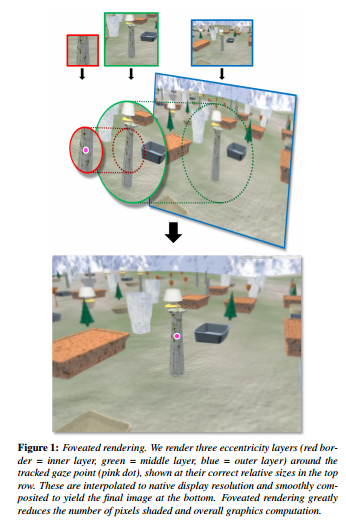
Still young, virtual reality technology is radically changing, improving, and growing. With all of these changes, virtual reality can be viewed both as a paradigm and as a medium in its initial phases. Many new technologies are being added to virtual reality software and hardware to improve controls, visuals, rendering, and portability. Today, I am going to discuss foveated rendering. This is a visual/rendering technology that will potentially push VR graphics found in adult virtual reality games and videos forward in a dramatic manner.
Foveated Rendering
Before getting into how foveated rendering works, I am going to discuss this complex word and the phenomena associated with it. Before learning about foveated rendering, I had never heard of this word. My lack of knowledge about this word is not related to the fact that I grew up in Germany. I am fluent in both English and German.
Foveated from the root noun foveation, is a particularly strange and uncommon English word. It is the act of “angling the eyes to focus on an object.” Vision specialists have figured out an ingenious way of using natural human tendencies of foveation to add extra detail to virtual reality worlds.
Paradigm

Image credit: Microsoft
Foveated rendering has arisen from the current VR development paradigm wherein developers consider how human vision can be emulated using lens technology, software techniques, and high pixel density low latency displays. In other words, virtual reality researchers and developers understand the necessity for VR technologies use technologies that integrate scientific understandings of human vision. In the case of foveated rendering, virtual reality specialists integrate eye tracking hardware and software, specialized rendering techniques and optimized processors.

FOVE headset. Image credit: FOVE
The Goals of Foveated Rendering
Human vision specialists define foveation as the phenomena where humans only keep small elements of their total perceived environments in focus. Research has demonstrated that when humans look at objects, they focus on a limited horizon or a small part of the viewed whole that is perceived. As a result, the rest of the whole not in focus is perceived as blurry and less detailed. So VR specialists are using this low level of focus and high level of non-focus to their advantage.
https://youtu.be/PeR4M9Vt02Q
The VR company FOVE aims to take advantage of this human vision phenomena. Their goal is to create a foveation model similar to polygon reduction level-of-detail systems that most 3D games use to reduce the number of polygons rendered at long distances that players can not see. Level-of-detail systems dramatically reduce rendering load.
FOVE’s goal is to reduce the number of rendered number of pixels by only rendering a high resolution within the sphere of a user’s focus. To understand where a user’s focus may be, eye tracking technology is used alongside special software tricks that allow eye-focus coordinates to be sent to the VR rendering system. At this point, based on what a user is looking at, the software then will render only a portion of the display as higher resolution.
Foveation and Adult Virtual Reality
For all of this to work, this system needs to be fast enough that users won’t see the switching between resolutions. So far FOVE says that this technique could increase processing speeds by 30 to 100 percent. This means that 3D interactive virtual reality adult games and 3D virtual reality porn will be able to increase details in character models and environments. As a result, this technology could lead to lifelike and sexy virtual reality characters that surpass anything that we see today.
Eye tracking and foveated rendering is undoubtedly the future of VR… I would like to see how successfully the developers can handle the switching between resolutions..
This is too technical but I know one thing, this will make my VR experience better and thats everything for me.
haha true
That’s awesome. But do you think it’s affordable for the market? I guess we’ll see…